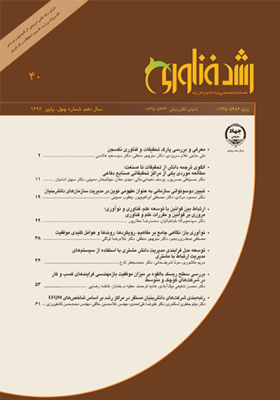تبیین دوسوتوانی سازمانی بهعنوان مفهومی نوین در مدیریت سازمانهای دانشبنیان
محورهای موضوعی : Technology Development Infrastructures and Supporting organizationsمحمود مرادی 1 , مصطفی ابراهیم پور ازبری 2 , یعقوب ممبینی 3 *
1 - -
2 - ادبیات و علوم انسانی
3 - -
کلید واژه: دوسوتوانی, دوسوتوانی متوالی, دوسوتوانی ساختاری, دوسوتوانی زمینهای, سازمانهای دانشبنیان.,
چکیده مقاله :
دوسوتوانی سازمانی به عنوان یک سازه جدید مدیریتی در سالهای اخیر مطرح شده است. این مفهوم در حال ورود به حوزههای فناوري، نوآوری، کارآفرینی، رفتار سازمانی، طراحی سازمانی و راهبرد میباشد. دوسوتوانی برای کسب مزیت رقابتی پایدار، عملکرد و بقای شرکتهای دانشبنیان مورد بحث بوده و بهوسیله تلاش سازمانها در بهرهبرداری و اکتشاف از فرصتهای موجود به دست میآید. سازمانهای دانشبنیان به منظور همافزایی علم و ثروت، توسعه اقتصاد دانشمحور و تحقق اهداف علمی و اقتصادی ایجاد میگردند و به شدت بر نوآوری به عنوان یک منبع رقابتی متکی هستند. در این مقاله از روش کتابخانهای و توصیفی برای تبیین مفهوم دوسوتوانی و انواع آن در سازمانهای دانشبنیان استفاده شده است. ما در این مقاله تلاش کردهایم تا این سازه جدید را تبیین کرده و انواع دوسوتوانی سازمانی در جهت بهبود عملکرد سازمانهای دانشبنیان را معرفی کنیم. سازمانهای دانشبنیان با حرکت به سمت دوسوتوانی میتوانند بقای خود را در دنیای پویای امروزی تضمین نمایند. در این مقاله پس از تعریف مفهوم دوسوتوانی سازمانی، ضرورت حرکت سازمانهای دانشبنیان به سوی دوسوتوان شدن و پیشینهای از موضوع ارائه و انواع دوسوتوانی متوالی، ساختاری و زمینهای موردبحث قرارگرفته است.
Organizational ambidexterity as a new managerial construct has been proposed in recent years. This concept is entering into the field of technology, innovation, entrepreneurship, organizational behavior, organizational design and strategy. Ambidexterity is viewed as a tool to gain sustainable competitive advantage, business performance and firm survival. It can be achieved through organizations’ endeavor to exploit and explore available opportunities. Many companies have comprised the view that to function effectively in today’s economy, it is indispensable to become a knowledge-based organization. The Knowledge Based Organizations created in order to synergistically exploit science and wealth, develop knowledge based economy and strongly depend on innovation as a source of the competitive advantage. In this article, by systematically reviewing related literature, we have tried to illuminate the notion of ambidexterity. Structures and forms of organization ambidexterity in knowledge based organizations were revised and its role to improve the performance of knowledge based organizations has been clarified. Paper suggested that knowledge based organization through ambidexterity in management, structure and process could guarantee its survival in today’s dynamic environment. In the paper, organizational ambidexterity definition in explained. Furthermore, the necessary that knowledge based organization must pass on toward ambidexterity in explained. The sequential ambidexterity, structural ambidexterity and contextual ambidexterity as foremost typologies for ambidexterity is discussed.

